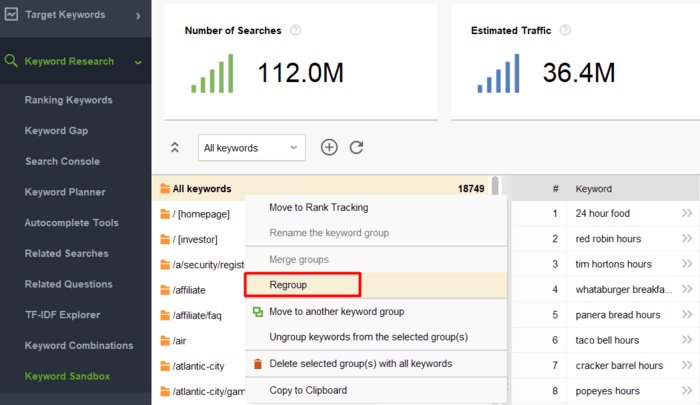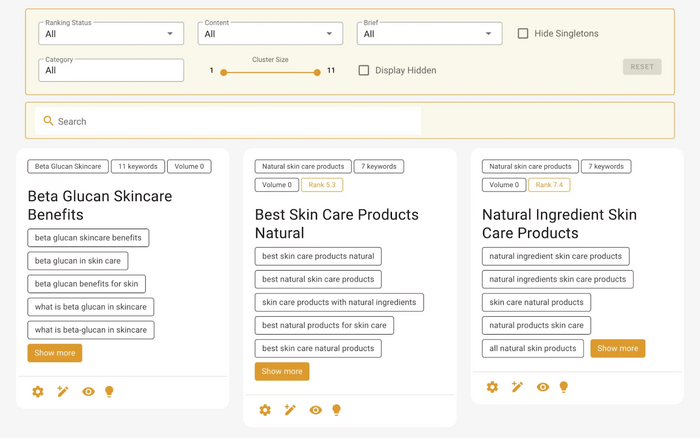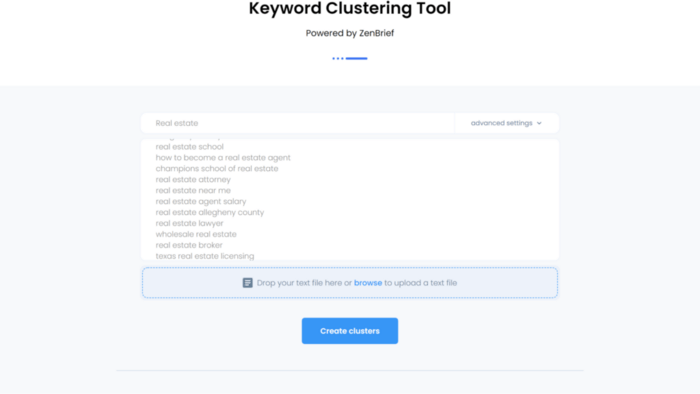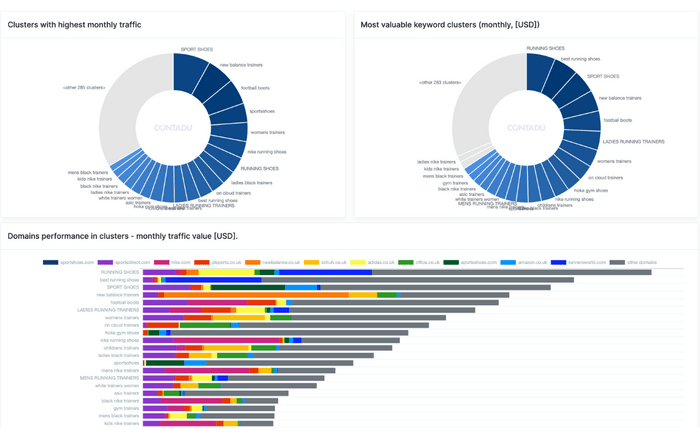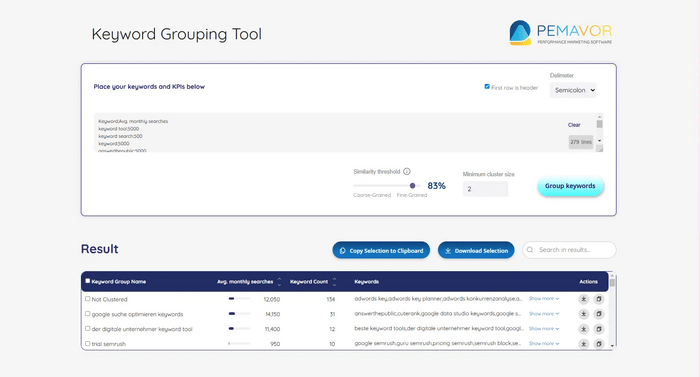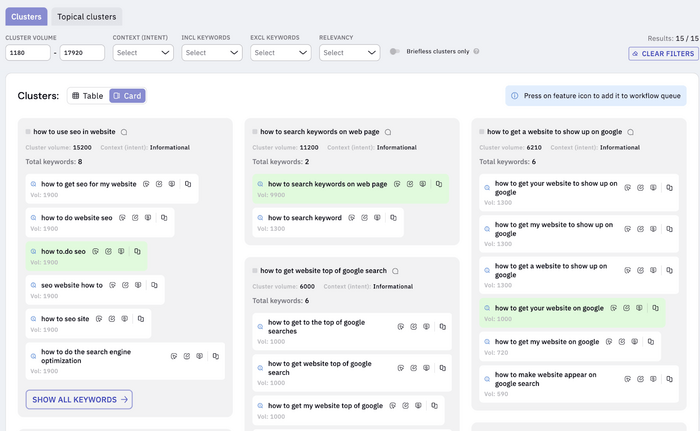Keyword Clustering: Best Practices + 6 Free Tools Compared

Finding the right keywords is only the beginning of a strong SEO strategy. The real challenge? Organizing them in a way that drives focused, relevant content—and gets results. That’s where keyword grouping comes in.
Keyword grouping (or keyword clustering) is the process of sorting your keyword list into logical clusters based on meaning, search intent, or SERP similarity. Done well, it helps you plan content that targets multiple related keywords in a single article, avoids keyword cannibalization, and builds topical authority across your site. But doing this manually—especially with hundreds or thousands of keywords—is time-consuming and error-prone.
Thankfully, there are tools that can automate keyword grouping for you. Some are free and simple, others are more advanced and use real-time SERP data to group keywords by what users are actually looking for. In this guide, we’ll walk through how keyword grouping fits into your content workflow, how to approach it strategically, and which tools are most effective—so you can spend less time organizing and more time creating high-performing content.
Keyword grouping best practices: from research to ranking
Keyword grouping is often one of the most important (and underrated) steps in one’s content strategy. It’s the bridge between collecting keywords and actually creating high-performing content. Think of it as the strategy layer between keyword research and content production.
Here’s how it fits into a typical SEO/content workflow:
Keyword research → Keyword grouping → Content mapping → Content creation
Let’s break that down:
- Keyword research gives you a list of ideas—but not all of them deserve their own page.
- Keyword grouping helps you organize those ideas into logical sets based on how closely they’re related (by meaning, intent, or Google’s actual search results).
- Content mapping takes those clusters and turns them into article outlines or page ideas.
- Content creation is where you write one strong piece for each keyword group.
Not all keyword clustering is created equal. How you group your keywords has a direct impact on how well your content ranks, how useful it is to your readers, and how efficiently you scale your SEO. Let’s break down the three most common (and effective) grouping methods:
1. Semantic similarity
This method groups keywords based on how similar they are in wording or meaning. It's about identifying terms that are essentially variations of the same idea.
For example:
- “best running shoes”
- “top sneakers for runners”
- “running footwear reviews”
All of these keywords talk about the same general topic — shoes for runners — but use different phrasing. Grouping them semantically means treating them as part of the same content asset (like a buyer's guide or review roundup).
Why it works: It’s a simple, intuitive way to start grouping. Most tools use semantic similarity as a baseline because it catches close matches and synonyms.
Limitations: It doesn’t always catch subtle differences in user intent. For instance, “best running shoes for men” and “best running shoes for flat feet” may sound alike but require different content angles.
2. Search intent matching
This approach looks beyond wording and focuses on what the user is trying to achieve with their search. It groups keywords based on the intent behind the query — whether users want to learn, compare, solve a problem, or buy.
For example:
- “how to tie a tie”
- “steps to tie a necktie”
- “necktie tying instructions”
Even though the wording varies, the intent is the same: the user wants a step-by-step guide. So these should be grouped together and answered in one helpful how-to article.
Why it works: Google increasingly ranks content that aligns with intent, not just keywords. Grouping by intent helps you deliver exactly what the searcher wants.
Limitations: Intent can be subjective or subtle. For example, “best productivity tools” might suggest an informational comparison, while “buy productivity software” signals a transactional intent — even if both include similar keywords.
3. SERP overlap
This is the most advanced — and accurate — way to group keywords. It involves checking the actual top-ranking results in Google for each keyword and seeing where they overlap.
For example:
- “homemade pizza dough”
- “easy pizza dough recipe”
These two queries might look different, but if the top 10 results on Google are largely the same, it means Google considers them closely related — and they can likely be targeted together in one well-optimized article.
Why it works: SERP overlap shows you how Google interprets keywords in real time. It reflects real user behavior and Google’s evolving understanding of language and topics.
Limitations: It’s slower to do manually (which is why smart tools automate this process). Also, SERPs change — so it requires up-to-date data.
Each method has its strengths, but combining all three — semantic similarity, intent matching, and SERP overlap — gives you the most accurate and actionable keyword groups for SEO.
Pro tips
- Don’t group just by exact-match terms. Two phrases can look different but mean the same thing. Use logic, not just keywords.
- Avoid “orphan” keywords. These are stray keywords that don’t fit any group. Try to connect them to a broader long-tail variation or use them in supporting content like FAQs or subheadings.
- Each group = one content asset. Once your clusters are defined, aim to create one clear, focused piece of content per group. That’s how you build authority and avoid cannibalization.
Keyword clusters vs. topic clusters: what’s the difference?
When planning SEO content at scale, it's easy to get lost in the terminology. Two phrases often thrown around are keyword clusters and topic clusters. While they sound similar, they serve different (but complementary) purposes in a solid content strategy.
Keyword clusters
Keyword clusters are groups of closely related search queries that all share the same intent or theme — and can be targeted together in a single piece of content.
Think of them as variations on the same question or topic. For example, a keyword cluster around “email marketing tools” might include:
- best email marketing software
- top email automation tools
- Mailchimp alternatives
- affordable email platforms
These keywords all reflect a similar user goal: finding a good email marketing solution. Rather than writing four separate articles, you'd create one comprehensive guide that targets all of these terms — using the keyword cluster to shape the headings, subtopics, and FAQs within that article.
Topic clusters
Topic clusters are a content architecture strategy. They involve creating a pillar page on a broad topic, supported by multiple cluster pages that dive into specific subtopics. All pages are internally linked to form a strong SEO hub.
Here’s how a topic cluster structure looks:
- Pillar page: “The Complete Guide to Email Marketing”
- Cluster page 1: “Best Email Marketing Tools for Small Businesses”
- Cluster page 2: “How to Create Your First Email Automation Workflow”
- Cluster page 3: “Email Subject Line Best Practices”
- Cluster page 4: “Understanding Email Metrics and Deliverability”
This format helps search engines understand how your content pieces are connected. It also improves user experience, since readers can easily explore related topics.
How keyword clusters and topic clusters work together
These two concepts are not competing — they complement each other beautifully:
- Use keyword clusters to optimize individual pages. Each cluster becomes the foundation of one strong, search-optimized article.
- Then group those articles into topic clusters, linking them to a central pillar page. This boosts authority on the main topic and helps you rank for broader, more competitive keywords.
For example, a keyword cluster could help you write an article titled “Top Email Automation Tools for 2024.” That article becomes one of several cluster pages in a broader topic cluster about email marketing.
In short, keyword clusters help you write better articles, and topic clusters help you organize them for long-term SEO growth. Mastering both puts you miles ahead in building scalable, rank-worthy content.
7 Best free keyword grouping tools
If you’re looking to streamline your content strategy and automate keyword clustering, the good news is you don’t need to break the bank. Several tools offer free keyword grouping features — perfect for getting started or testing different methods.
Here are 6 tools that stand out, starting with the powerful Rank Tracker.
1. Rank Tracker by SEO PowerSuite
Rank Tracker is a robust desktop application that includes a built-in keyword grouping tool as part of its all-in-one SEO suite. Once you’ve imported your keyword list, Rank Tracker allows you to group keywords automatically based on common terms or semantic similarity.
You can choose how aggressive the grouping is by adjusting the number of words that must match in each cluster.
What makes Rank Tracker especially useful is its seamless integration with other features like rank monitoring, competitor analysis, and reporting. You can easily turn keyword clusters into rank-tracking projects or build content plans based on ranking opportunities. It’s ideal for SEOs who want full control and like working offline with large datasets.
The free version includes keyword grouping capabilities and allows for ongoing testing. For power users, the paid version unlocks unlimited data storage, advanced filters, and more competitive intelligence tools.
Pros:
- Fully customizable keyword grouping rules
- Combines keyword clustering with rank tracking and reporting
- Keyword research and competitor analysis insights
Cons:
- Not cloud-based (requires software installation)
- UI can feel overwhelming for beginners
2. Thruuu Keyword Clustering Tool
Thruuu offers a SERP-based keyword clustering tool that groups keywords by analyzing actual Google results. This approach ensures you're not just grouping keywords based on similar wording but based on intent and topical overlap as understood by Google.
The tool supports keyword imports (CSV or plain text) and quickly generates clusters, which can then be turned into optimized content briefs with competitor data (headings, word count, FAQs, etc.). It's a great choice for content teams looking for both clustering and content planning features in one place.
The free plan allows you to cluster up to 500 keywords — a generous starting point. For deeper usage and advanced brief generation, paid plans are available.
Pros:
- SERP-based clustering for better accuracy
- Integrated with a content brief generator
Cons:
- Limited free usage over time
- Brief builder features locked behind paid plans
3. Zenbrief Keyword Clustering Tool
Zenbrief is a content optimization platform that includes a free keyword clustering feature. It uses NLP (Natural Language Processing) to group keywords based on semantic similarity, offering a more evolved alternative to basic word-matching tools.
Its clean interface makes it beginner-friendly. You can upload your keywords via file or text input, adjust the cluster size, and download your results easily. While it lacks advanced features like SERP overlap or competitor data, it's a solid free tool for small projects or getting started with keyword grouping.
The free version allows clustering of up to 30,000 keywords per project — a surprisingly high limit for a freemium tool.
Pros:
- Easy to use with a clear interface
- Fast processing time
Cons:
- No SERP analysis
- Limited to semantic-based clustering
- No keyword metrics like search volume included
4. Contadu Keyword Clustering Tool
Contadu is a full-stack content intelligence platform that includes a keyword clustering module. You can choose between clustering based on common subwords or assigning keywords to predefined groups. This flexibility gives users more control than many other free tools.
The UI is straightforward, and you can copy/export your results easily. It also supports multiple languages, which is great for international SEO teams. However, the clustering algorithm is quite basic — mainly lemma-based — which can result in mismatched intent across clusters.
Contadu’s keyword clustering tool is accessible under a free plan, though advanced features like topic modeling and content scoring are reserved for paid users.
Pros:
- Two keyword grouping modes for more flexibility
- Multi-language support
- Up to 100,000 keywords supported
Cons:
- No advanced clustering logic (no SERP or intent analysis)
- No keyword import from files (copy-paste only)
- Few customization options
5. Pemavor Keyword Grouping Tool
Pemavor offers a lightweight, browser-based keyword grouping tool with no sign-up required. It’s built for simplicity: paste your list, choose the similarity threshold, and watch as it clusters your keywords into small groups.
While it doesn’t use SERP data or NLP, it provides basic semantic grouping that can be fine-tuned with a similarity slider. It’s best for users who want a quick and free way to break down keywords into manageable sets, without heavy SEO features or content planning tools.
You can cluster up to 10,000 keywords at a time and export the results in CSV format. It’s ideal for small teams or quick projects.
Pros:
- No login or sign-up needed
- Adjustable similarity threshold
- Simple UI with copy/export options
Cons:
- Basic semantic clustering only
- No content planning or SEO metrics
- No file upload option (paste only)
6. Keyword Insights clustering tool
Keyword Insights provides advanced keyword clustering using a mix of SERP analysis and machine learning. Their free tool allows you to test the platform by clustering a limited set of keywords, making it a good entry point for understanding how SERP-based grouping works.
The tool displays how keywords were grouped, the confidence level, and whether each group should be its own page or combined into one. It’s designed with SEO professionals in mind, offering guidance on how to act on the clustering results.
While the full version is paid, the free demo is enough to get a feel for the quality of the clustering logic.
Pros:
- Uses SERP similarity for more accurate clusters
- Provides intent and page-level suggestions
- Includes confidence scoring per cluster
Cons:
- Free plan is very limited (demo only)
- Requires email to access
- Paid version can get expensive for large projects
Final thoughts & a bonus checklist
Keyword grouping is one of those behind-the-scenes steps that can quietly determine whether your content succeeds or stalls. It brings order to chaos, transforms messy keyword lists into strategic content plans, and helps you create pages that are both useful to readers and favored by search engines.
Whether you're working with 50 keywords or 5,000, following a clear process makes a huge difference. So before you dive into content creation, walk through this simple, repeatable checklist to ensure you're building with purpose.
Keyword grouping checklist: from idea to execution
- Start with a focused keyword list
Use a research tool to collect relevant search terms across your niche or topic. - Clean up the noise
Remove duplicates, brand names, and unrelated queries that don’t align with your goals. - Choose a grouping method
Group by semantic similarity, user intent, or SERP overlap — ideally a blend of all three. - Use a keyword clustering tool
Save time by automating your grouping with tools like Rank Tracker, Thruuu, or Zenbrief. - Tweak settings and refine clusters
Adjust thresholds, merge or split groups, and add manual logic where needed. - Label and document each cluster clearly
Give each group a name that reflects the core idea or search intent. - Plan one article per cluster
Treat each group as a content asset — a blog post, landing page, or resource guide. - Avoid keyword cannibalization
Ensure no two clusters compete for the same intent or SERP position. - Build topic clusters for depth
Connect related articles to a central pillar page with smart internal linking. - Revisit your clusters often
SERPs evolve. So should your keyword strategy. Audit and refine every few months.
Keyword grouping isn’t just a tactical SEO move — it’s how you build clarity into your content strategy. It helps you stop guessing and start creating with confidence. And thanks to the growing ecosystem of free and affordable tools, it's easier than ever to get started.
So take the time to group your keywords before writing your next article. You’ll save hours down the line, and your content will perform better in search from day one.



